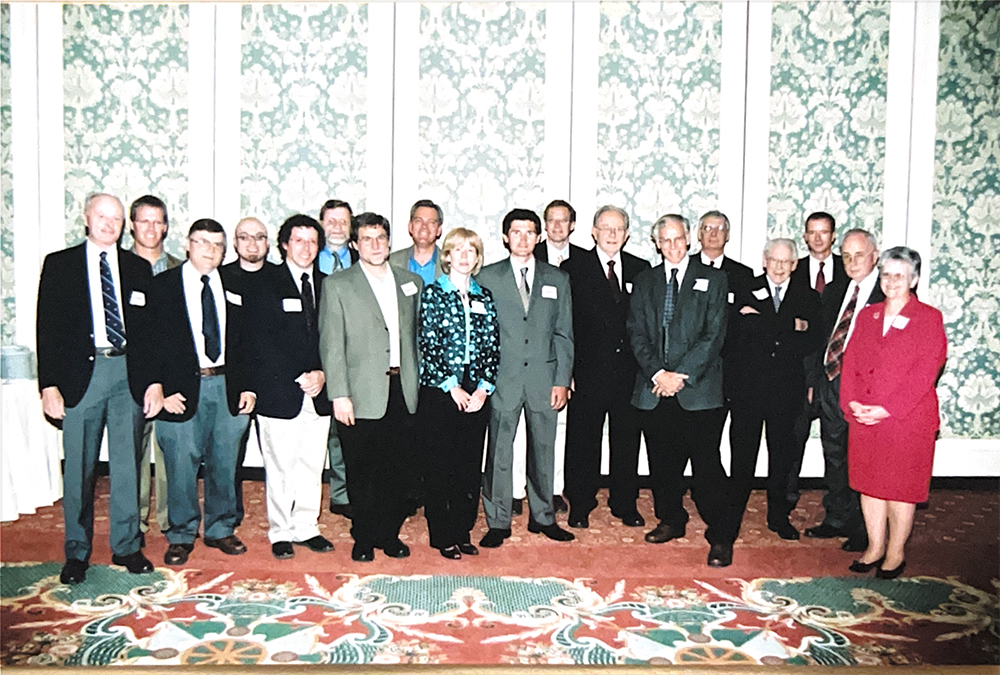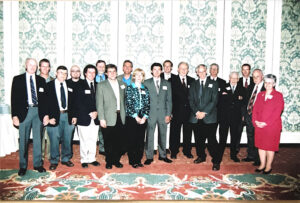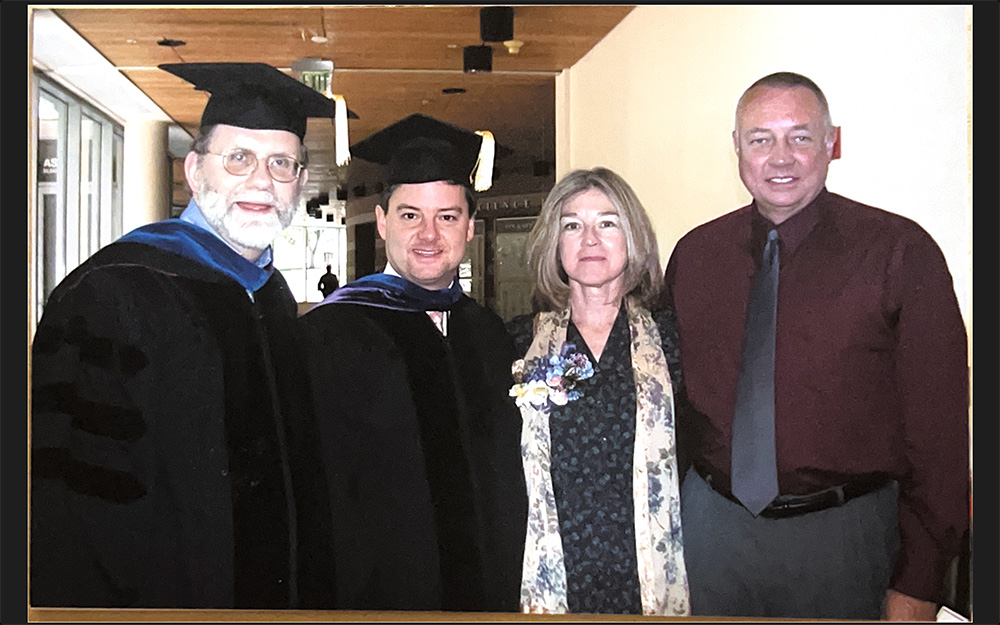
In the spring of 2009, the University was notified that $8M from the NIH had been awarded for construction of a major addition to the so-called “south tower” of the Henry Eyring Chemistry Building. At the time of the new NIH award it was clear that at least $10M additional [funds] would be required beyond the $8M in NIH funds to complete the project. Associate Professor Greg Owens was promptly deputized as “Director of Development” to lead this ambitious fundraising campaign.
On April 15, 2009, the College of Science hosted an “Eyring Legacy Event” in collaboration with the University Office of Development. The main event was a dinner in the Tower of Rice Eccles Stadium. Attendees included fourteen of the late Professor Henry Eyring’s former research students, members of Henry Eyring’s family, the three members of the LDS Church First Presidency, notable local political figures, members of the Chemistry faculty, and many other invitees.

In Fall 2009, The Catalyst Alumni Newsletter of the Chemistry Department, no volume number, had morphed into THE CATALYST CHEMISTRY NEWSLETTER, Volume 1, Number 1, Fall 2009 with a dazzling array of color photographs not found in the issue of the defunct Newsletter. Prof. Henry White was continuing as Department Chair and noted that Chemistry was still accomplishing much despite draconian State of Utah budget cuts.
The “Faculty Profile” story was about Assistant Professor Kenneth Woysechowsky who had come to Utah from upstate New York via a B.S. at Penn State, a Ph.D. at U. Wisconsin – Madison, and a postdoc. at the ETH in Zurich, Switzerland. One of Ken’s research foci continues to be issues related to icosahedral capsids (“soccer balls”) commonly found in viruses.
One of the challenges of having strong Utah Chemistry faculty is the inevitable competition with other strong departments for our chemists at every level of development. Examples of this problem in the history of the U. of Utah Chemistry Department abound. Josef Michl leaving Utah for Austin, Texas immediately after his election to the National Academy of Sciences is a particularly painful example. Another troubling example was the departure of Jean Futrell, bound for the University of Delaware. Just as unexpected was the decision of John Gladysz to leave in 1998 for a Chair in Germany after 16 very fruitful years elevating the prestige of inorganic chemistry at Utah. More recent disappointing losses include Greg Voth departing for the University of Chicago, the husband-wife team of Peter Beal and Sheila David decamping for the University of California, Davis, and Eric Hagg joining his wife at Michigan State University. What these and many other lateral transfers within academic chemistry have in common is more resources immediately available to the transferee at the far end of the move. If the Chair of the Utah Chemistry Department had had the endowment funds enjoyed by the Departments with which we were competing some of these unhappy losses could have been avoided. That reality makes stories about large donations to endowments particularly encouraging news.
The Thatcher Company in Salt Lake City made a multi-year pledge to create a four-year full tuition undergraduate scholarship in Chemistry or Chemical Engineering. The first recipient was Natascha Knowlton of Magna, UT. She was also the 2009 Cyprus High School Sterling Scholar in foreign language.
Dr. Rebecca Uhlig, a practicing optometrist working in Portland, Oregon was mentored in the Utah Chemistry Department by Professor Laya Kesner. Rebecca created in 2009 the Laya Kesner Award to be given to an undergraduate chemistry major who has demonstrated teamwork and support of her/his fellow students’ learning experience while in the classroom or lab.
Life sketches of three prematurely deceased Chemistry Department students are also given in the Catalyst, Fall 2009, Vol. 1, No. 1 issue. Their names are Jennifer Alexander, Christopher Nielsen, and Masaaki Tamayama.
Recognitions of Faculty Members mentioned in this Catalyst issue include the following: Prof. John Conboy promoted to rank of Full Professor
Prof. Gary Keck received the University of Utah Distinguished Teaching Award Prof. Joel Miller was elected Fellow of AAAS
Prof. Valeria Molinero received the Beckman Young Investigator Award
Prof. Peter Armentrout was given the Field and Franklin Award for Outstanding Achievement in Mass Spectrometry
Prof. Jennifer Shumaker-Parry received an NSF Career Award
Prof. Matthew S. Sigman received the Robert W. Parry Teaching Award endowed by the Brady Foundation
Prof. Ilya Zharov was promoted to Associate Professor and received the IUPAC Young Observer Award and was named University Distinguished Honors Professor
Debbie Olson, Department Secretary, received the W. W. Epstein Outstanding Educator Award
Prof. Holly Sebahar also received the W. W. Epstein Outstanding Educator Award
There is a gap in copies of the Catalyst (University of Utah) Chemistry Newsletter between Volume 1, Number 1, Fall 2009 and the Biannual Catalyst Newsletter, Fall 2012, that has no volume number and no issue number.
The Curie Club was invented and first convened sometime during this three-year interval. A few events from this interval in the Chemistry Department History are the following:
May 28, 2009, Dr. Bill Jack (Duke Univ. Ph.D., 1983; Native Salt Laker) visited and talked about “Polymerases and Other DNA Enzymes.”
September 21, 2009, Lucy Ziurys, University of Arizona, boss of Kitt Peak and Mount Graham, Astronomical Observatories, spoke on “Molecular Spectroscopy Beyond the Solar System: A Physical Chemist’s Approach to Astrochemistry.”
January 21, 2010. Dr. Bethany Buck-Koehntop, Scripps Research Institute, spoke on “DNA recognition by the Methyl-CpG Binding Zinc Finger Protein Kaiso.” Bethany subsequently joined the Utah Chemistry faculty.
58th ASMS Conference on Mass Spectroscopy in Salt Palace, May 23-27, 2010. Peter Armentrout spoke to an audience of about 4,000 attendees on May 23. Dr. Marvin Vestal (Futtrell Ph.D.) was an awardee on May 24 for a Distinguished Contribution to Mass Spectrometry. Prof. Tsutomu Masujima (former Postdoc in Ted Eyring lab) brought 20 of his coworkers from Hiroshima, Japan and spoke to a reasonable crowd on Thursday morning, May 27th about “Robotized Video-Mass Scope for Direct and Live Single-cell Molecular Exploration.”
April 6, 2010, Inorganic Colloquium, Dr. Fred Hawthorne, Univ. of Missouri, Columbia, “Polyhedra Boranes in the Biomedical Area,” hosted by Joel Miller.
A retirement reception for Dr. Jerry Driscoll was held on June 15, 2010. His matchless gift for the classroom demonstrating chemical principles enriched all our lives. He now resides in Hawaii.
May 9, 2011, John Maier, University of Basel, Switzerland, “Electronic Spectroscopy of Carbon Chains, Rings and Ions of Relevance to Astrophysics,” Host: Prof. Michael Morse.
June 25, 2011, Chair Henry White and a few others from Chemistry attended a polo match at the South Jordan Equestrian Park to see how the College of Pharmacy raises money for a new pharmacy research building. The event was financed by Claudia Skaggs Lutrell, whose daughter was one of the polo pony riders.

